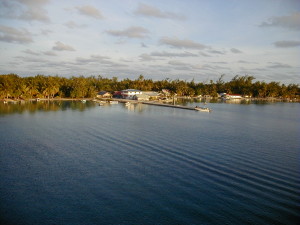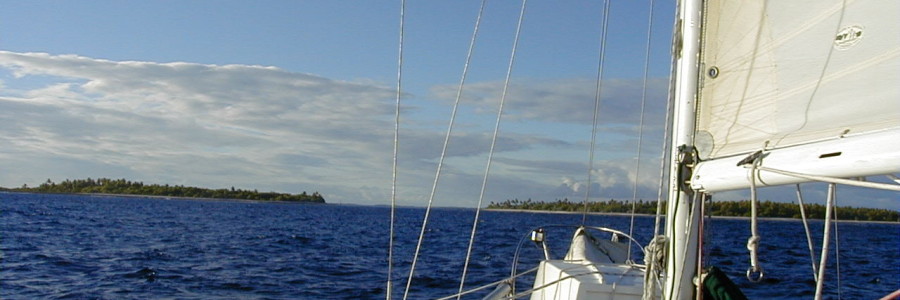The atoll of Ahe in the Tuamotos is a place of many contrasts. The ocean
swell born of the trade winds comes all the way from the coast of Central
and South America; Ahe is a refuge from the relentless rolling movement of
the seas outside it’s reefed protection. Eons ago, Ahe, like many of its
neighboring atolls, was once and island that has sunk into the ocean. All
that remains is the circular shape of the coral reef that is constantly
trying to grow towards the surface. There is a pass through this reef
that the supply ships and cruising boats can enter the tranquil waters
inside. Five miles across the atoll is yet another almost circle of
coral, this one much smaller. A circle within a circle providing
protection for the village wharf and waterfront. Cruising boats and local
outboard power boats enjoy the lakelike setting.
Where the Marquesan Islands to the north are steep, get lots of rain and
have many waterfalls, Ahe is low to the water, the highest point of land
may be 20 feet above the level of the ocean. The nutrient rich Marquesan
soil is ideal for growing abundant fruit while the white coral sand of Ahe
is only sufficient to support palm trees, low flowery shrubs and the
occasional banana tree. Every house in Ahe has a carefully crafted roof,
gutter and tank system to catch the precious rain that falls from the
occasional squall, while the Marquesas have freshwater streams running
through most villages and pressure water outlets regularly spaced along
the streets. On Sundays the large churches of the Marquesas are filled to
overflowing. Ahe is only able to draw a small portion of its population
to its plain but sturdy looking church. Regardless of the size of the
congregation the energy and singing are infectious and should not be
missed.

The July 14th Bastille day celebration is a great excuse for a party to
the Polynesian locals who find little meaning in the French independence
day. Papeete on Tahiti some 300 miles to the southwest is the tourist
center of these islands has a two-week celebration, with many dance, canoe
and other local competitions drawing immense crowds. Ahe has only a two
day celebration bringing out the endless local talent in games, dancing
and singing. Of course there is competition, but instead of gold medals
as would be given in the states, Ahe is much more practical with food
staples of rice and sugar as prizes. The higher award winners walked off
with half a cow while a few even scored a new bicycle. The grand prize
donated by the new airline, Air Tahiti Nui was a round trip ticket to Los
Angeles. This award likely gives the recipient a taste of popular culture
they are so desperate for, but may also give them a dose of how the rest
of the world lives. Perhaps they will be happy to return home.
Unlike the tourism income earned in Hawaii and Tahiti, Ahe takes advantage
of it’s clean water unpolluted by fertilizers and sewage to farm pearl
producing oysters. These oysters, sensitive to temperature, predators and
pollutants survive well enough to provide the coveted South Pacific Black
Pearl in quantities that make a comfortable living for those who work
here. The clothes are new, as are the outboard motors on the work boats.
Houses are comfortable and tastefully decorated on the inside. However,
there is also evidence of too much drinking here in Ahe. New wealth, but
not many outlets for spending it. No movies, no dance clubs, no
restaurants, no coffeehouses. The motu the village is on is perhaps 1/2
mile long and 1/4 mile wide. It’s rather humorous to see people on
scooters zipping around, one assumes, in circles on this tiny atoll.
There are even a few cars and trucks. The family at the end of the road
saved themselves a walk to the Bastille Day celebrations by driving their
car less than 1/4 mile to the town hall where the plywood stage was set up
in the street. This way, they had comfortable seats as well.
All in all, Ahe is a hard working, and somewhat sleepy little backwater.
They do have quite a bit of contact with the big world beyond through
their lucrative pearl trade. And they also have a strong sense of
community and place. All the characters of the small town saga are here:
the Mayor, the Policeman, the Postmistress, the Priest, two shop keepers,
parents watching the children play, the young people entering adulthood,
the boys eyeing the girls, the girls deciding if they will notice or not,
young men at the wharf drinking beer, a knot of older men from which a
whiff of pot is smelled and whispers of “whiskey” are heard. One is
reminded that one of Agatha Christie’s detectives, Miss Marple, learned
all she needed to know about human character from studying the inhabitants
of a small town. A place as laid back as Ahe is perhaps not as simple as
one first suspects.
